Eye to Eye with the Ceiling of Michelangelo’s Sistine Chapel
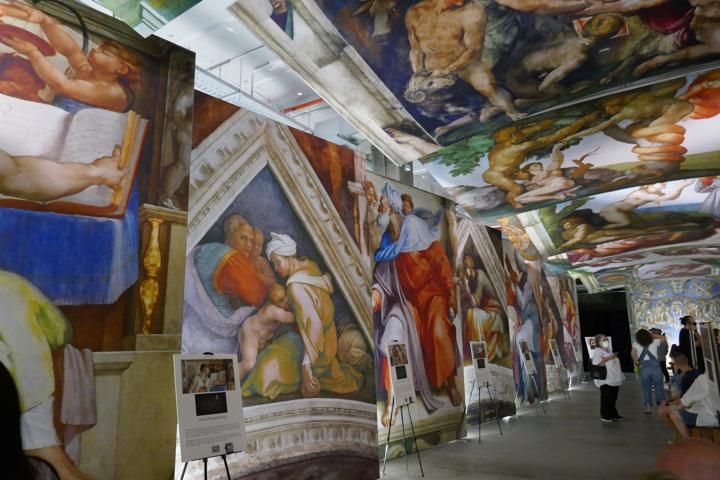
Tucked away above a large Melbourne shopping centre is a small exhibition space featuring 34 of Michelangelo's magnificent frescos from The Sistine Chapel located in the Vatican, Rome – displayed at full size and at eye level, as you can see in the image above.
These unique reproductions have been brought to life using a special printing technique that emulates the look and feel of the original paintings, giving visitors the chance to engage with the artwork in ways that were never before possible: seeing every detail, every brushstroke, and every colour.1
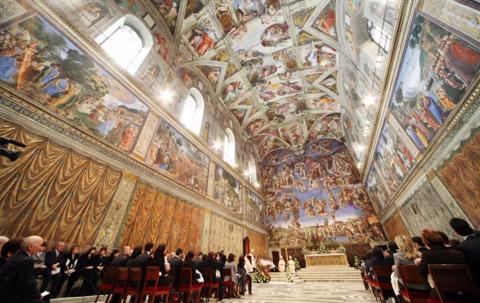
Anyone who has visited the Sistine Chapel knows that craning your neck to view the ceiling, 20 metres above, is not easy and studying the intricate details of these masterpieces is impossible.
Before we take a look as some of the close-ups displayed at the exhibition, here are some details of the building and the chapel.
The grand chapel that is known around the world as the Sistine Chapel was built from 1475-1481 at the behest of Pope Sixtus IV. The monumental room measures 40.23 meters long by 13.40 meters wide (134 by 44 feet) and reaches 20.7 meters (about 67.9 feet) above the ground at its highest point. The floor is inlaid with polychrome marble and the room contains an altar, a small choristers' gallery, and a six-paneled marble screen that divides the room into areas for clergy and congregants.
Michelangelo's frescoes on the ceiling and the altar are the most famous paintings in the Sistine Chapel. Pope Julius II commissioned the master artist to paint these parts of the chapel in 1508, some 25 years after the walls had been painted by the likes of Sandro Botticelli, Ghirlandaio, Perugino, Pinturrichio, and others.2
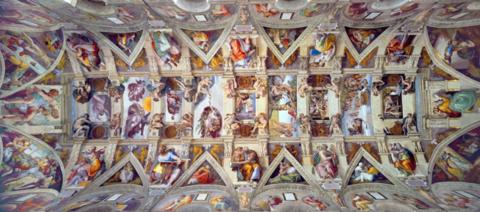
Michelangelo began to work on the frescoes on the ceiling for Pope Julius II in 1508, replacing a blue ceiling dotted with stars. Originally, the pope asked Michelangelo to paint the ceiling with a geometric ornament, and place the twelve apostles in spandrels around the decoration. Michelangelo proposed instead to paint the Old Testament scenes now found on the vault, divided by architectural elements that he used to organize the composition.3
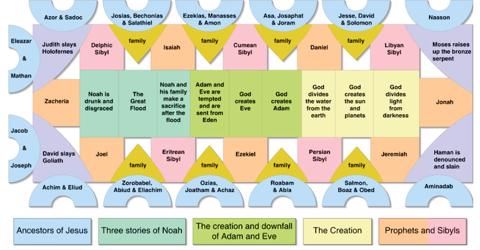
The result is 9 central panels, which depict The Creation of the World, The Expulsion of Adam and Eve, and The Story of Noah.
Ignudi, or nude youths, sit in architectural segments around these frescoes, and are accompanied by prophets and sibyls (ancient seers who, according to tradition, foretold the coming of Christ) in the spandrels. In the four corners of the room, in the pendentives, one finds scenes depicting the Salvation of Israel.3
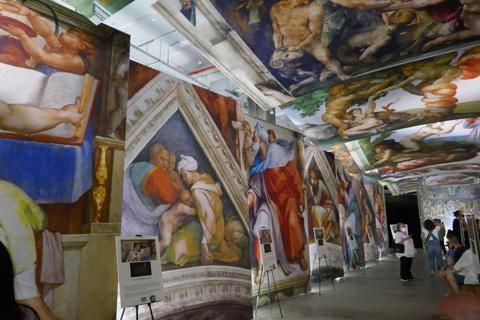
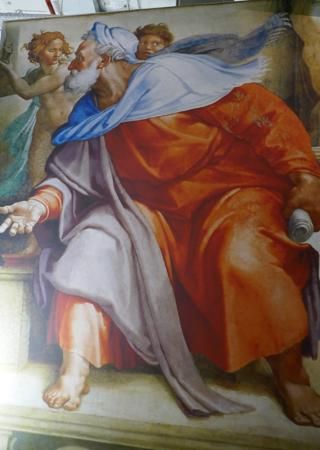
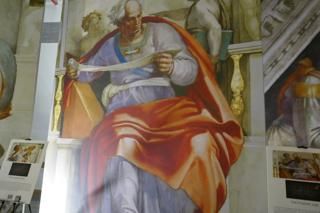
Along the walls of the exhibition we could closely study the reproductions of some of the prophets. Above are just two:
The priest and prophet Ezekiel lived in the early 60s century BC. Michelangelo depicts him as an old man who was engrossed in his reading, but has now suddenly turned around to look behind him, as his gaze is focused on the hands of the small accompanying figure in the background, which are stretching up towards the heavens. They refer to the source of God’s message. Gestures play a central role in a large number of the frescoes painted by Michelangelo as a keels open right hand for example can also be understood as a gesture of both amazement and to receive the message.
Joel is one of the oldest prophets in the Old Testament. Michelangelo shows him in a fully concentrated pose, with his attention focused on the writing on the parchment scroll in his hands. Joel heralded a divine punishment that would be inflicted on the sinful Israelites in the form of an army. Michelangelo used a large amount of detail when painting the profits facial expression with Joles puckered brow and wrinkled forehead bearing reference to his sorrowful prophecy.4
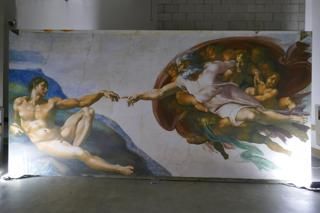
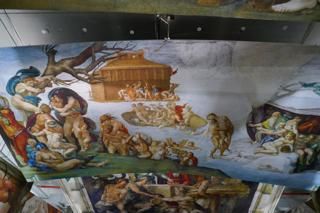
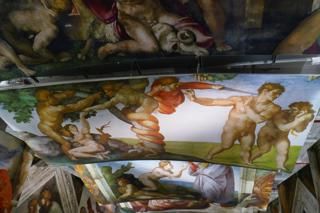
Above us, but much closer at the exhibition, we can study some of the ceiling frescos. Above are three:
The Creation of Adam is the most famous painting of the ceiling frescoes. Adam lies casually in the left-hand side of the image while the dynamic figure of God approaches from the right. The figure of God, depicted in front of a flowing red robe is surrounded by a multitude of small beings. The point of focus in this composition is not, however, the small figures but the implied yet incomplete contact between God and his greater creation mankind.
The Great Flood is the largest punishment inflicted by God for the sins of mankind. According to Genesis God sent 40 days of rain in order to erase all life on earth, sparing only Noah and his family. He told Noah to build a boat, the Arc. In Michelangelo’s painting, the Arc is in the background and the white dove is depicted in one of its hatches as a symbol of hope. The foreground is dominated by a multitude of people trying in vain to save themselves, their loved ones and even their possessions, from the flood.
The fall of man and the expulsion from paradise depicts the story of the first man and woman - Adam and Eve. In this painting Michelangelo chose to combine two successive scenes. The left-hand side of the image shows the fall of man, with Eve taking the fruit of knowledge from the serpent and in doing so, going against God’s will. The painting also shows Adam reaching out for fruit from the tree. On the right-hand side the archangel Michael uses his extended sword to expel the sinners from paradise.4
If you would like to see more of the magnificent Sistine Chapel, enjoy this 6 min video by Khan Academy.
We cannot leave the Sistine Chapel without mentioning the The Last Judgement Altar Fresco and nearby walls.
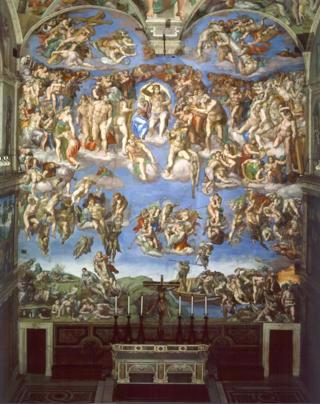
The Last Judgement Altar Fresco was painted much later in 1535. This giant fresco above the Sistine Chapel altar depicts some gruesome scenes from The Last Judgment. The composition depicts hell as is described by the poet Dante in his Divine Comedy. At the center of the painting is a judgmental, vengeful Christ and he is surrounded on all sides by nude figures, including apostles and saints. The fresco is divided into the blessed souls, at left, and the damned, at right. Note the image of the flayed body of Saint Bartholomew, on which Michelangelo painted his own face.
The North Wall of the Sistine Chapel to the right of the altar contains scenes from the life of Christ, while the South Wall contains scenes from the life of Moses.2
Credits:
1. Secretmelbourne.com
2. tripsavvy.com
3. khanacandamy.org
4. Details taken from the storyboards at the exhibition
